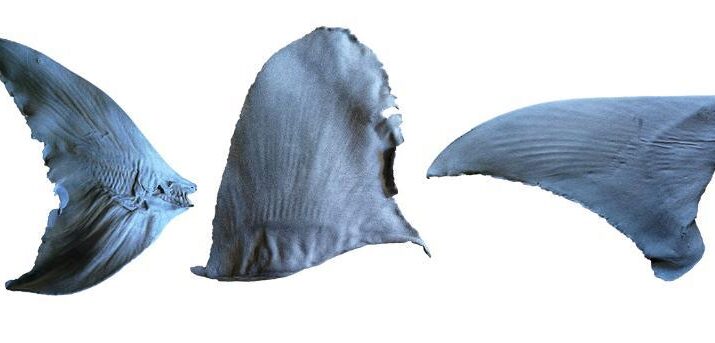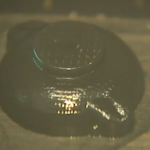

The practice of shark finning has said to have increased due to demand for these appendages for soup and traditional medicines in the Asia-Pacific region. Estimates put the value of the global shark fin market at multiple billions of dollars. This profit, however, results in the death of 73-100 million sharks annually, in turn wiping out species and causing damage to the surrounding ecosystem. Now, over 40 species are listed in the Convention on International Trade in Endangered Species of Wild Fauna and Flora (CITES), regulating the export of wildlife products.
TRAFFIC, one of the most well-known anti-poaching organizations, has developed a library of 3D printable shark fins to educate customs agents about the variety of shark fins that they may encounter while enforcing laws related to wildlife trade. The non-government organization (NGO) used laser scanning to capture 3D models of a number of dried fins from CITES-listed species, collected by shark expert Debra Abercrombie, who had used them for training customs and fishery officials globally.
Blue Shark fin (pectoral) are 3D laser scanned using 3D image software. Photo: Markus Bürgener
The idea to 3D print replicas was conceived by Charlene da Silva, a shark scientist with the South African Department of Forestry, Fisheries and Environment (DFFE). With funding from the Arcadia fund, TRAFFIC set about scanning Abercrombie’s artifacts and preparing them for 3D printing via selective laser sintering. The rough finish of the nylon not only mimicked the texture of dried shark fins, but also made it easier to paint the replicas.
The replica shark fins after 3D printing using sintered nylon as the main material for printing (Bowmouth Guitarfish (Rhina ancylostoma) caudal fin, Oceanic Whitetip Carcharhinus longimanus dorsal fin, and Great Hammerhead Sphyrna mokarran pectoral fin)
Artists from Cosmesis Advanced Prosthetics in Cape Town were able to color the fins based on photos and reference cards, with multiple layers of paint used to achieve the proper markings and identifying features. The Oceanic Whitetip sharks, for instance, feature mottled markings that customs agents can use for easy identification. Next, QR codes were embedded on the fins to allow officials to quickly pull up information about the species with a smartphone.

Replica shark fins after painting (Bowmouth Guitarfish (Rhina ancylostoma) caudal fin, Oceanic Whitetip Carcharhinus longimanus dorsal fin, and Great Hammerhead Sphyrna mokarran pectoral fin)
To further spread the use of these tools, TRAFFIC has uploaded their models online. Now, anyone who works for a protection organization can download the 22 shark fins from 11 species and print them. Painting them would, of course, make them that much more useful, but the NGO’s online guide provides steps on how to create the best replicas.
Obviously, the need to protect shark species is crucial in an ecosystem that is undergoing a devastating collapse. How that is performed is another matter. There is no inherent problem with distributing files for 3D printable shark fin replicas, but one might question the larger NGO and trade network behind CITES.
This trade agreement was established in 1975 in response to elephant and rhino poaching on the African continent, as well as larger trade issues, including the timber industry. TRAFFIC is a joint program created by the World Wildlife Fund (WWF) and the International Union for the Conservation of Nature (IUCN), both of which have been subject to some serious and sometimes disturbing criticisms.
Both have been accused of putting the needs of corporate sponsors over those of ecosystems, wildlife, and indigenous populations. In the case of the WWF, the organization was accused of funding paramilitary groups responsible for human rights abuses in the parks where they operated. There is even evidence that, in the 1980s, it was involved in activities related to violently putting down anti-apartheid activists and trading endangered wildlife products.
For these reasons, some have argued that CITES has acted more as tool for economically targeting non-Western/Northern countries for their role in the trade of wildlife products. NGOs like the WWF, IUCN and TRAFFIC, then can help enforce imbalanced trade relationships and, if the WWF has continued to participate in similar activities as it did in the 1980s, could even aid in interstate conflict. In his book, At the Hand of Man, former New York Times and New Yorker journalist Raymond Bonner documented how the WWF pressured some African nations to support a CITES ban on ivory despite their reluctance, due to the dependence of their economies on the trade.
Nevertheless, those behind TRAFFIC project here are likely unaware of these complex relationships and are simply doing their best to educate the proper authorities on how to identify shark fins. For this, we can commend the effort for its uniqueness and as a possible model for educating others.
When it comes to 3D real estate visualization in the USA, our service provides the perfect solution for bringing property listings to life. Through our platform, you can easily access cutting-edge 3D renderings that showcase your real estate projects in a way that attracts potential buyers and investors. Whether it's residential, commercial, or mixed-use properties, our team of experts uses advanced technology to create immersive visualizations that highlight the best features of your property, making it easier for clients to imagine the space as their own.
Through our website, you can quickly get high-quality 3D real estate visualizations that are tailored to your specific needs. With our help, you'll stand out in the competitive real estate market by offering potential buyers a realistic, interactive view of your property. Our efficient process ensures a fast turnaround time, while our attention to detail guarantees that every aspect of the property is represented accurately, giving you a powerful marketing tool to promote your real estate listings.






